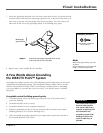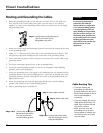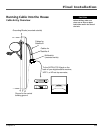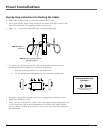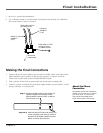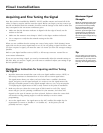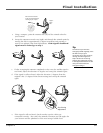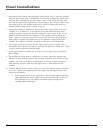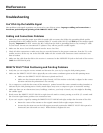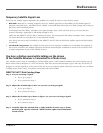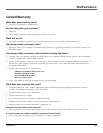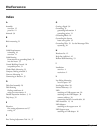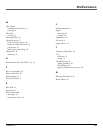
Chapter 4 41
Reference
Temporary Satellite Signal Loss
If you lose the satellite signal temporarily, the problem can usually be traced to one of these points:
1. Rain Fade. Rain fade is a normal, temporary loss of a satellite signal due to the inability of the satellite signal to
penetrate unusually heavy, rain-filled clouds, rainfall, or snowfall. Rain fade tends to be brief, lasting only as long as
the heavy cloud condition persists.
To minimize rain fade effects, maximize your signal strength. Then, when rain fade occurs, you have the best
chances of having a signal that is still strong enough to view.
Make sure the DIRECTV PLUS™ dish is mounted securely. The strong winds that often accompany heavy rainstorms
can move the dish out of position if it is not mounted securely.
Also, heavy/wet snow and ice buildup on the DIRECTV PLUS™ dish can block the satellite signal until the buildup
is removed.
2. Overheated Components. The satellite receiver must receive adequate ventilation to work safely and properly. If
the receiver overheats, the satellite signal may deteriorate until adequate ventilation is restored. Do not stack VCRs
or other components on top of the satellite receiver.
You hear a dialing sound while talking on the phone
(If the Satellite Receiver is Connected to a Phone Line)
Your satellite receiver may be attempting to call the billing center. Under normal conditions, the receiver hangs up any
time it detects what it interprets as a voice on the line. After four unsuccessful attempts to get a dial tone, the receiver is
designed to call out regardless of the status of the line. If you’re using the phone when the receiver calls out, you’ll hear
a dialing sound. Don’t worry: your phone connection will not be broken.
DIRECTV PLUS™ Dish Pointing Steps
Step 1: Are you receiving a signal?
• If yes, go to Step 4.
• If no, proceed to Step 2.
Step 2: Adjust the azimuth right or left. Are you now receiving a signal?
• If yes, go to Step 4.
• If no, proceed to Step 3.
Step 3: Adjust the elevation up or down 1 degree. Are you now receiving a signal?
• If yes, proceed to Step 4.
• If no, return to Step 1.
Step 4: Carefully adjust the azimuth (left or right) and the elevation (up or down)
until the peak signal is achieved. When finished, tighten the azimuth and
elevation bolts.



